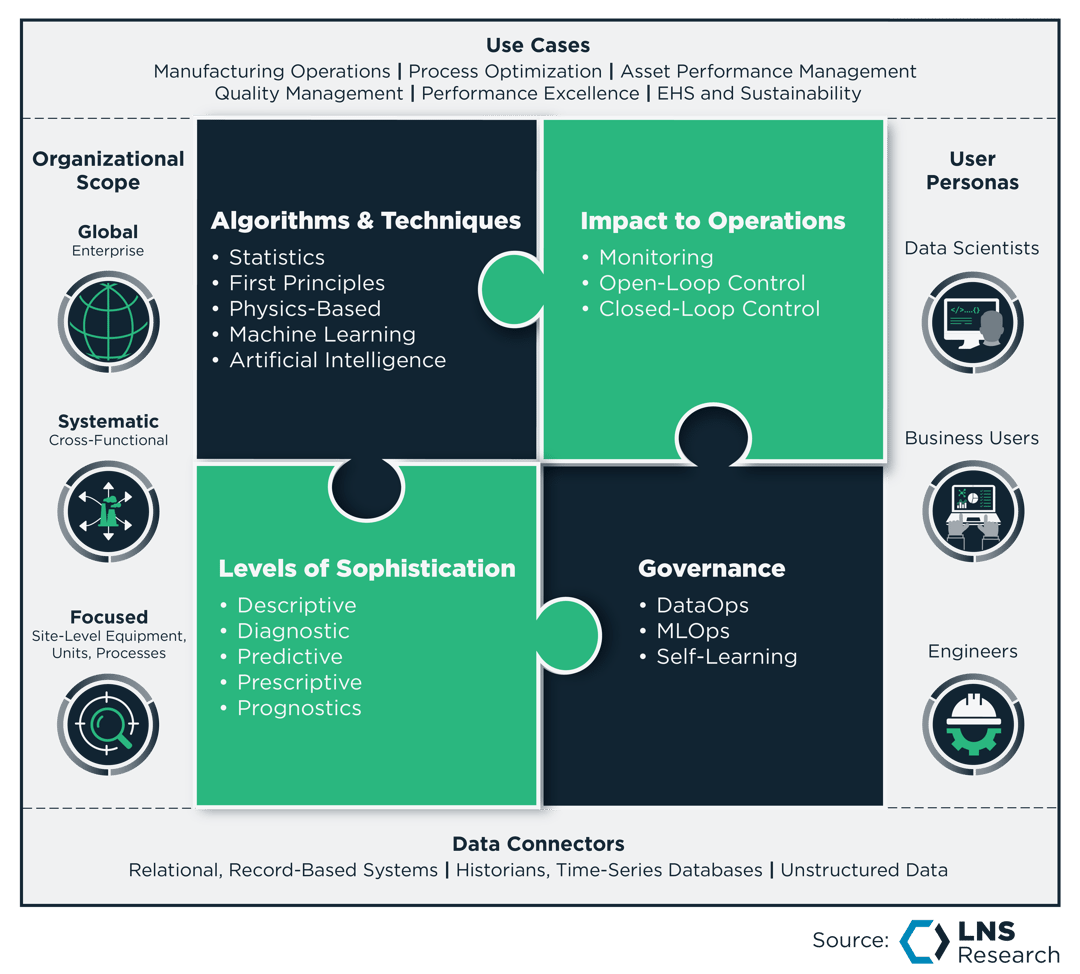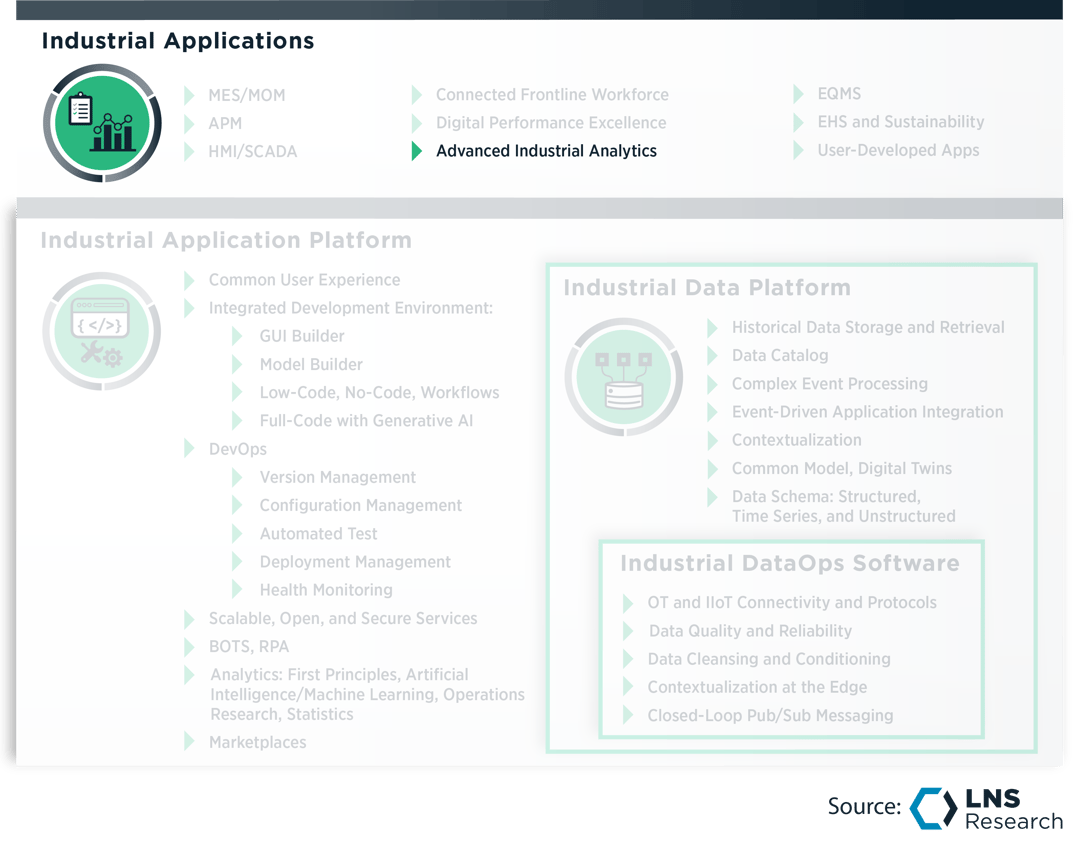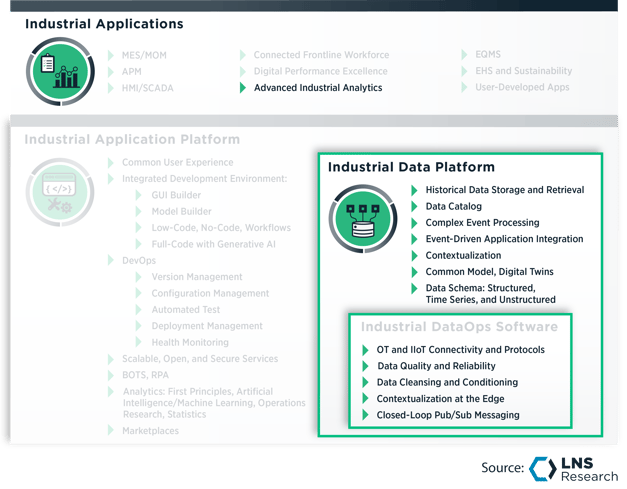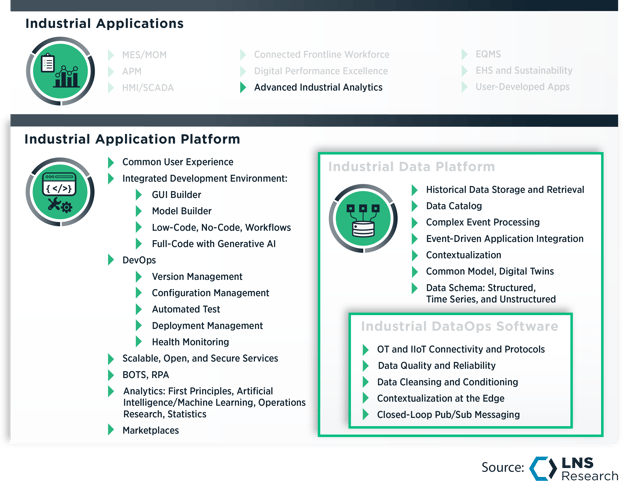An Updated Definition of the Technology Category, IX Reference Architecture, and the AIA Solution Selection Matrix
In my seven years at LNS Research, I've noticed that the research and advisory business has become increasingly dynamic and fast-moving. Most of the duties of an industry analyst, such as conducting primary research, defining technology categories, and evaluating vendor landscapes, have become more nuanced, requiring frequent updates to keep up with this increasing pace of change.
While this fast-moving nature of business certainly applies to all areas, it is especially true for my primary focus here at LNS Research - Advanced Industrial Analytics and Operational Architecture, where disruption and innovation have continued at breakneck speed over the last few years; this brings me to this blog post.
At this point, I think it’s important to provide an update on three topics relevant to my research: the definition of Advanced Industrial Analytics (AIA) as a technology category, its position within the Industrial Transformation (IX) Reference Architecture, and LNS Research’s upcoming Advanced Industrial Analytics Solution Selection Matrix (SSM).
An Updated Definition of Advanced Industrial Analytics
Over the years, LNS Research has published several research reports and thought leadership frameworks on Advanced Industrial Analytics, including the levels of analytics sophistication, the underlying data architecture, use cases, user personas across the organization, etc. As mentioned above, due to the evolving nature of these characteristics, we have updated the definition to keep up with the pace of technology innovation and market dynamics.
LNS Research defines Advanced Industrial Analytics as the process of collecting, modeling, and analyzing industrial data through industrial-grade software applications that enable end users to identify patterns, trends, and insights using a set of proprietary and/or open-source analytic techniques and algorithms.
The AIA applications usually integrate with internal or external platforms, data connectors, and edge-to-cloud agents that facilitate data connectivity, modeling, and contextualization techniques required for effective analysis. Built on this data foundation, the applications then use several statistics, such as first principle, physics-based, and machine learning (ML) algorithms, to provide insights of varying levels of sophistication across the descriptive–prognostic spectrum.
From an organizational perspective, the AIA applications typically target one or two layers in an industrial organization. They could either be focused on individual equipment/process units or be systematically running in the background, covering multiple units, work cells, or even plants, or span the breadth of the enterprise at a global level.
Finally, these applications should ideally deliver value across several industrial use cases – including (but not limited to) asset performance, quality, manufacturing, productivity, process optimization, EHS, sustainability, etc., and target multiple user personas, such as engineers (industrial, process, reliability engineers), business users (cross-functional operations, quality, supply-chain, EHS personnel), and data scientists (data engineers, wranglers stewards, scientists, software engineers).
The definition mentioned above and function blocks are what we at LNS Research perceive as essential pieces of Advanced Industrial Analytics software; we will use the same to assess qualified, competing vendors as part of the upcoming Solution Selection Matrix, further detailed below.
Readers should note that although the (AIA) space is still maturing, only a handful of vendors currently offer most of the capabilities listed in the above definition (and none offer 100%). While we expect that to change soon enough, as of this writing, most end users will need to consolidate multiple products and vendors for their Advanced Industrial Analytics requirements.
AIA in the Updated Industrial Transformation (IX) Reference Architecture
The LNS Research IX Reference Architecture was originally published in 2020 as a set of technology capabilities required to enable Industrial Transformation. While the set of capabilities accurately described the then amorphous nature of the IX technology landscape, the past couple of years have witnessed considerable disruption, innovation, mergers, acquisitions, and partnerships that led to clear shapes and boundaries being formed between technology categories and products that serve those categories.
As a result, LNS Research recently published a revised version of the IX Reference Architecture that accurately describes the most recent state of the IX technology landscape - as a set of licensable product categories that have taken shape and formed over the past few years. A description of the updated product category Reference Architecture can be found here.%20Reference%20Architecture-2.png?width=1080&height=1132&name=Industrial%20Transformation%20(IX)%20Reference%20Architecture-2.png)
Advanced Industrial Analytics vendors compete in this new reference architecture in three categories: Industrial Applications, Industrial Data Platforms, and Industrial Application Platforms.
-
-
-
Industrial Applications
The first category includes vendors that license their Advanced Industrial Analytics capabilities through software applications. These applications provide some data connectivity, modeling, and contextualization; however, their core functionalities include advanced analytics engines that leverage several statistical, first principle, physics-based, and machine learning algorithms that identify patterns, trends, correlations, and causations for their target user personas.
While most of the vendors in this category have built the applications on an internal data or app-building platform, the platform itself is not open or licensable on its own. Customers can only license and access the applications, not modify or extend the platform with custom code (outside of APIs offered) or build custom applications without the vendor's involvement.
-
Industrial Data Platforms
The second category includes data platform vendors that primarily aim to bring together multiple data sources across IT and OT. The data platform provides robust data connectivity through pre-built connectors, APIs, webhooks, etc. It provides several Industrial DataOps capabilities such as data quality, conditioning and contextualization, and orchestration to store this modeled data in a cloud infrastructure. Ideally, these Industrial Data Platforms need to collect, store, and model structured, time-series, and unstructured data (pureplay historians and time-series databases won't count).
End users will then be able to perform Advanced Industrial Analytics through out-of-the-box applications pre-built on the data platform. Readers should note that most vendors in this category also provide a no-code/low-code environment for end users to build custom applications. Still, their primary focus is on delivering AIA capabilities through their data platform and pre-built applications.
-
Industrial Application Platforms
The final category of the IX Reference Architecture that applies to Advanced Industrial Analytics includes a wide variety of established operations and enterprise software companies, automation providers, and start-ups that provide advanced analytics capabilities through an application platform. Similar to a data platform, the application platform aims to bring IT and OT data together in a homogeneous environment but lacks some of the deeper data conditioning, contextualization, and modeling capabilities that are especially critical to managing OT data.
Also similar to the data platform vendors, the application vendors provide a set of out-of-the-box applications built on their platforms that cover several advanced analytics use cases. However, where they differ is that, unlike the data platforms, the application platforms aim to add the most value through their no-code/low-code app-building environment.
The Updated AIA Solution Selection Matrix
The third and final topic I want to provide an update on is LNS Research's upcoming Advanced Industrial Analytics Solution Selection Matrix (SSM).
Most of our readers know that over the past few months, LNS Research has been working on an SSM focused on Advanced Industrial Analytics vendors. However, this project proved more challenging than some of our other SSMs due to the vendor landscape's overcrowded nature and the vendors' heterogeneous nature. The shortlisted vendors (30+) provided different sets of analytics capabilities, served different user personas, and did not necessarily compete with each other for the most part, making the process of evaluating them in one matrix both cumbersome and of little to no value to the end user.
We decided to group the shortlisted vendors into multiple categories to address these shortcomings, resulting in fewer but comparable and competing vendors across multiple matrices. While the original approach was to group them based on user personas, we quickly shifted gears since most vendors target multiple user personas, and the approach did not effectively address the original shortcomings.
As a result, the latest approach to the SSM will be classifying Advanced Industrial Analytics vendors based on their position in the IX Reference Architecture, resulting in three separate matrices, namely:
-
-
-
Advanced Industrial Analytics by Application providers,
-
Advanced Industrial Analytics by Data platform providers,
-
Advanced Industrial Analytics by Application platform providers.
While the technology evaluated is the same (Advanced Industrial Analytics), each assessed category will be treated as a separate Solution Selection Matrix. As previously mentioned, the Industrial Data Platform and Industrial Application Platform providers have a broad set of data modeling and application-building functionalities. However, the AIA SSM will only assess their ability to deliver Advanced Industrial Analytics capabilities, excluding the underlying platform capabilities (to be assessed in later SSMs).
The three AIA SSMs will be launched separately and sequentially over the next few months: the AIA by Application provider SSM first, followed by the Data Platform and Application Platform providers SSMs.
Future blog posts will dive deeper into the Advanced Industrial Analytics definition and qualified vendors that will be assessed as part of each of the three SSMs. Keep an eye out for more details coming soon.
